
The Vauxhall Chevette is a supermini car that was manufactured by Vauxhall in the United Kingdom from 1975 to 1984. It was Vauxhall's version of the "T-Car" small-car family from Vauxhall's parent General Motors (GM), and based primarily on the Opel Kadett C. The family also included the Isuzu Gemini in Japan, the Holden Gemini in Australia, the Chevrolet Chevette in the United States, Canada, Brazil, Colombia, Ecuador and Argentina, and in the U.S. and Canada it was also rebadged as the Pontiac Acadian/Pontiac T1000.

The Vauxhall Astra is a compact car/small family car (C-segment) that has been sold by Vauxhall since 1980. Over its eight generations, it has been made at several GM/Opel/Stellantis plants around Europe - however most versions have been sourced from Vauxhall's plant at Ellesmere Port, Cheshire, England.
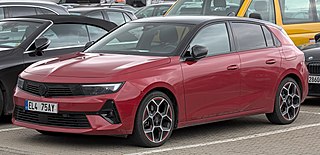
The Opel Astra is a compact car/small family car (C-segment) developed and produced by the German automaker Opel since 1991, currently at its sixth generation. It was first launched in September 1991 as a direct replacement to the Opel Kadett. As of 2022, the car slots between the smaller Corsa supermini and the larger Insignia large family car.
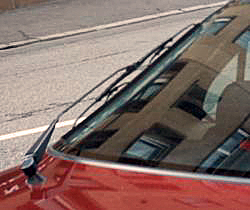
A windscreen wiper or windshield wiper is a device used to remove rain, snow, ice, washer fluid, water, or debris from a vehicle's front window. Almost all motor vehicles, including cars, trucks, buses, train locomotives, and watercraft with a cabin—and some aircraft—are equipped with one or more such wipers, which are usually a legal requirement.

The European Car of the Year (ECOTY) award is an international Car of the Year award established in 1964 by a collective of automobile magazines from different countries in Europe. The current organising companies of the award are Auto (Italy), Autocar, Autopista (Spain), Autovisie (Netherlands), L'Automobile Magazine (France), Stern (Germany) and Vi Bilägare (Sweden).

A police car is a ground vehicle used by police and law enforcement for transportation during patrols and responses to calls for service. A type of emergency vehicle, police cars are used by police officers to patrol a beat, quickly reach incident scenes, and transport and temporarily detain suspects, all while establishing a police presence and providing visible crime deterrence.

The Citroën C15 is a panel van produced by the French manufacturer Citroën from late 1984 until 2006. It was the successor to the Citroën Acadiane, which had replaced the Citroën 2CV vans that pioneered the box van format from the 1950s to the 1970s, although the Acadiane continued in production alongside the C15 initially. The name refers to the car's 1,500 kg (3,310 lb) French gross vehicle weight rating and indicates its position beneath the C25 and C35 in Citroën's commercial vehicle range at the time.
A military police vehicle is a vehicle used by the military police entities of a country's armed forces.
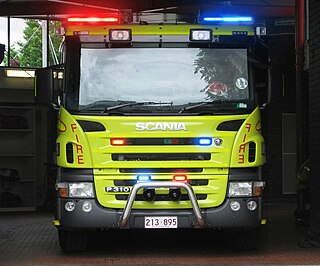
Emergency vehicle lighting, also known as simply emergency lighting or emergency lights, is a type of vehicle lighting used to visually announce a vehicle's presence to other road users. A sub-type of emergency vehicle equipment, emergency vehicle lighting is generally used by emergency vehicles and other authorized vehicles in a variety of colors.

Haldex Traction is a manufacturer of intelligent all-wheel drive (AWD) systems, founded in Sweden. Since invention of Gen I in 1998, the company produced several generations of products licensed to and customized for some major automotive brands, that in turn have marketed Haldex Traction AWD under different names. On 17 December 2010, American-based BorgWarner announced that it had signed an agreement to acquire the Traction Systems division of Haldex AB. BorgWarner completed the acquisition of the Traction Systems division on 1 February 2011. Haldex Traction Systems was incorporated in BorgWarner TorqTransfer Systems.

The Polícia de Segurança PúblicaMHTE is the national civil police force of Portugal. Part of the Portuguese security forces, the mission of the PSP is to defend Republican democracy, safeguarding internal security and the rights of its citizens. Despite many other functions, the force is generally known for policing urban areas with uniformed police officers, while rural areas are normally policed by National Republican Guard (GNR), the country's national gendarmerie force. PSP is focused in preventive policing, only investigating minor crimes. Investigation of serious crimes falls under the Judicial Police responsibility, which is a separate agency.

The Gendarmerie (French) or Rijkswacht (Dutch) was the former national Gendarmerie force of the Kingdom of Belgium. It became a civilian police organisation in 1992, a status it retained until 1 January 2001, when it was, together with the other existing police forces in Belgium, abolished and replaced by the Federal Police and the Local Police.

The C-segment is the 3rd category of the European segments for passenger cars and is described as "medium cars". It is equivalent to the Euro NCAP "small family car" size class, and the compact car category in the United States.
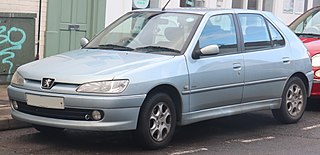
The Peugeot 306 is a small family car built by the French car manufacturer Peugeot from 1993 to 2002. It replaced the 309. Peugeot gave the 306 many updates and aesthetic changes to keep up with the competition, and it was replaced by the 307 in 2001. Cabriolet and estate versions continued until 2002. Versions were built in Argentina by Sevel from 1996 to 2002.

Law enforcement in Belgium is conducted by an integrated police service structured on the federal and local levels, made up of the Federal Police and the Local Police. Both forces are autonomous and subordinate to different authorities, but linked in regard to reciprocal support, recruitment, manpower mobility and common training.

The Slovenian National Police Force is the national government agency that handles the responsibility of law enforcement of the Republic of Slovenia. It is composed of the eight police directorates in Celje, Koper, Kranj, Ljubljana, Maribor, Murska Sobota, Nova Gorica, and Novo Mesto. Law enforcement in Slovenia is governed by the Slovenian Ministry of Internal Affairs. The police force maintains a number of international partnerships with foreign police forces, including training with the U.S. Federal Bureau of Investigation, and involvement in Albania and Kosovo with the Multinational Advisory Police Element. The Slovenian police force was admitted to Organization for Security and Co-operation in Europe on March 24, 1992.
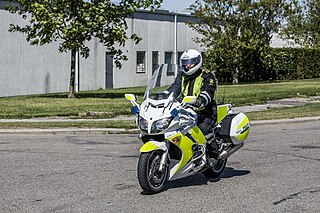
The Police of Denmark is the Danish National Police force, and the interior part of the Danish security forces in the Kingdom. The police are empowered to enforce the law and to effect public and social order, as well as being responsible for border control.
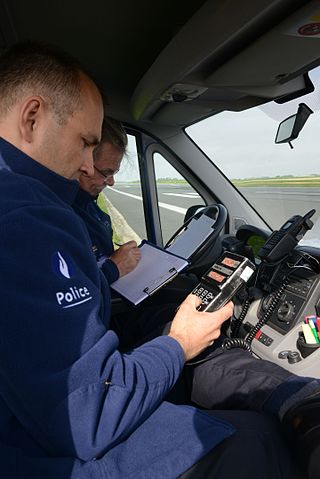
The Belgian Federal Police is the national police force of the Kingdom of Belgium. It carries out specialized and supra-local administrative and judicial police operations, and supports local police services when needed. Additionally, the Federal Police is responsible for patrolling and ensuring the safety of the country's highways. The Federal Police has approximately 12,300 officers and civilian personnel.

National Police Corps, colloquially in English as Dutch National Police or National Police Force, is divided in ten regional units, a central unit, the police academy, police services center, and national dispatch center cooperation. The law-enforcement purposes of these agencies are the investigation of suspected criminal activity, referral of the results of investigations to the courts, and the temporary detention of suspected criminals pending judicial action. Law enforcement agencies, to varying degrees at different levels of government and in different agencies, are also commonly charged with the responsibilities of deterring criminal activity and preventing the successful commission of crimes in progress. The police commissioner in the Netherlands is Henk van Essen since May 1, 2020.

The Police of Finland is a national government agency responsible for general police and law enforcement matters in the Republic of Finland. The Police of Finland is subordinate to the Ministry of the Interior and consists of the National Police Board, two national police units and 11 local police departments.


















